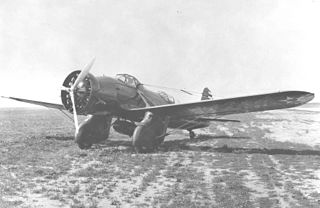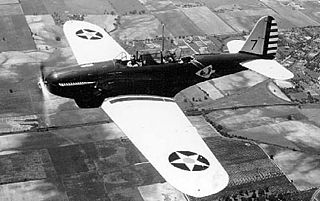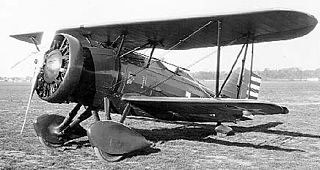
The Curtiss Falcon was a family of military biplane aircraft built by the American aircraft manufacturer Curtiss Aeroplane and Motor Company during the 1920s. Most saw service as part of the United States Army Air Corps as observation aircraft with the designations O-1 and O-11, or as the attack aircraft designated the A-3 Falcon.

The Curtiss A-12 Shrike was the United States Army Air Corps' second monoplane ground-attack aircraft, and its main attack aircraft through most of the 1930s. It was based on the A-8, but had a radial engine instead of the A-8's inline, water-cooled engine, as well as other changes.

The Curtiss A-8 was a low-wing monoplane ground-attack aircraft built by the United States company Curtiss Aeroplane and Motor Company, designed in response to a 1929 United States Army Air Corps requirement for an attack aircraft to replace the A-3 Falcon. The Model 59 "Shrike" was designated XA-8.

The Curtiss XF14C was an American naval fighter aircraft. It was developed by Curtiss-Wright in response to a request by the United States Navy in 1941 to produce a new shipboard high-performance fighter aircraft.

The Curtiss P-6 Hawk is an American single-engine biplane fighter introduced into service in the late 1920s with the United States Army Air Corps and operated until the late 1930s prior to the outbreak of World War II.

The North American O-47 is an American observation fixed-wing aircraft monoplane designed in the mid-1930s and used by the United States Army Air Corps during the Second World War. It has a low-wing configuration, retractable landing gear, and a three-blade propeller.

The P-1 Hawk was a 1920s open-cockpit biplane fighter aircraft of the United States Army Air Corps. An earlier variant of the same aircraft had been designated PW-8 prior to 1925.

The Curtiss F11C Goshawk is an American naval biplane fighter aircraft that saw limited success. It was part of a long line of Curtiss Hawk airplanes built by the Curtiss Aeroplane and Motor Company for the American military.

The Curtiss YA-10 Shrike was a 1930s United States test and development version of the A-8 Shrike ground-attack aircraft using various radial engines in place of the inline engine.

The Curtiss A-18Model 76A Shrike II was a 1930s United States twin-engine ground-attack aircraft. It was the production test version of that company's A-14 Shrike.

The Consolidated P-30 (PB-2) was a 1930s United States two-seat fighter aircraft. An attack version called the A-11 was also built, along with 2 Y1P-25 prototypes and YP-27, Y1P-28, and XP-33 proposals. The P-30 is significant for being the first fighter in United States Army Air Corps service to have retractable landing gear, an enclosed and heated cockpit for the pilot, and an exhaust-driven turbo-supercharger for altitude operation.

The Curtiss F6C Hawk was a late 1920s American naval biplane fighter aircraft. It was part of the long line of Curtiss Hawk airplanes built by the Curtiss Aeroplane and Motor Company for the American military.

The Curtiss F7C Seahawk was a carrier-capable biplane fighter aircraft of the United States Navy Marine Corps in the late 1920s and early 1930s.

The Naval Aircraft Factory TS-1 was an early biplane fighter aircraft of the United States Navy, serving from 1922 to 1929.

The XP-13 Viper was a prototype biplane fighter aircraft designed by the American company Thomas-Morse Aircraft Corporation. The airplane was delivered to the United States Army in 1929, but they did not adopt it.

The Douglas O-31 was the Douglas Aircraft Company's first monoplane observation straight-wing aircraft used by the United States Army Air Corps.

The Douglas O-43 was a monoplane observation aircraft used by the United States Army Air Corps.

The Consolidated PT-1 Trusty was a biplane primary trainer used by the United States Army Air Service (USAAS).

The Consolidated Model 2 was a training airplane used by the United States Army Air Corps, under the designation PT-3 and the United States Navy under the designation NY-1.

The Curtiss YP-20 was an American biplane fighter project developed by Curtiss for the United States Army Air Service.




















